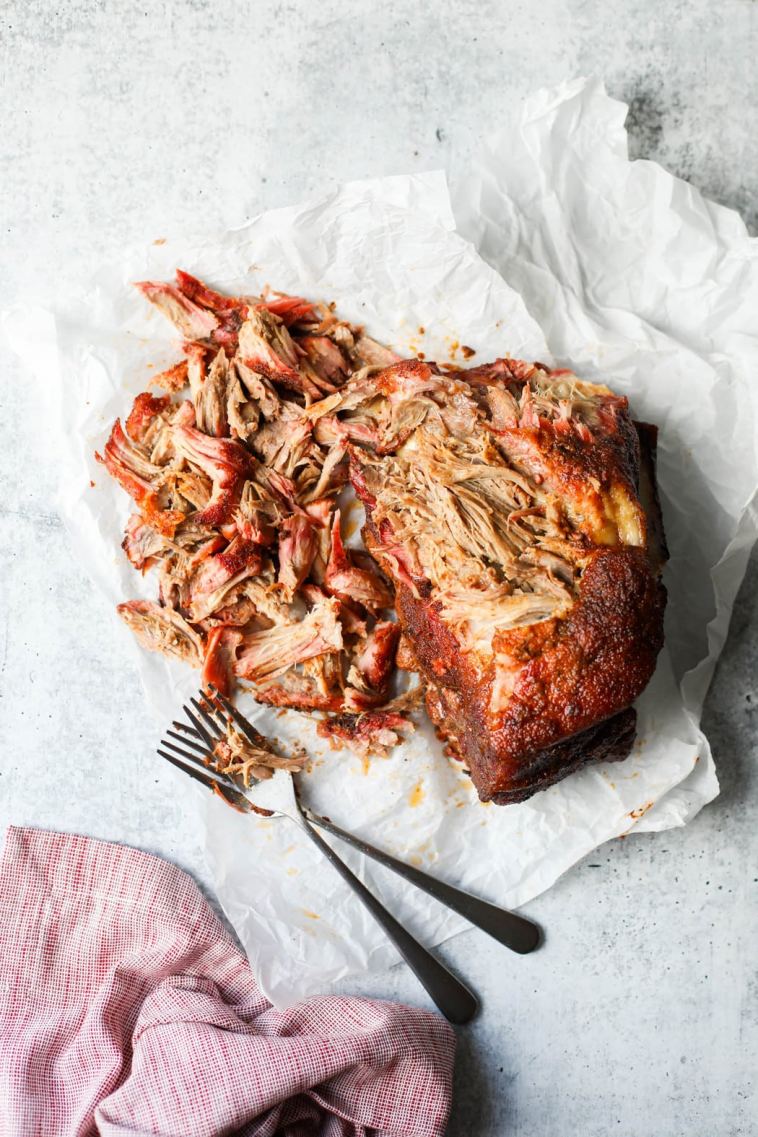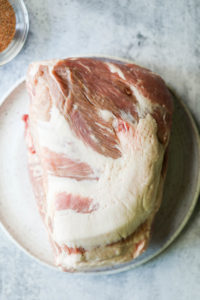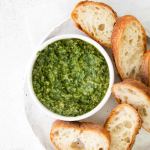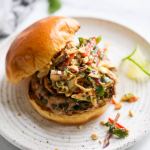- Like
- SHARE
- Digg
- Del
- Tumblr
- VKontakte
- Flattr
- Buffer
- Love This
- Save
- Odnoklassniki
- Meneame
- Blogger
- Amazon
- Yahoo Mail
- Gmail
- AOL
- Newsvine
- HackerNews
- Evernote
- MySpace
- Mail.ru
- Viadeo
- Line
- Comments
- Yummly
- SMS
- Viber
- Telegram
- JOIN
- Skype
- Facebook Messenger
- Kakao
- LiveJournal
- Yammer
- Edgar
- Fintel
- Mix
- Instapaper
- Copy Link
Smoking a big cut of meat can seem a little intimidating at first, but we’ve made it easy to do at home with this step-by-step recipe and photo tutorial for the best smoked pork butt you’ll ever make. Don’t blame us if everyone suddenly wants to come to your place for dinner!

This recipe was created in partnership with our friends and farmers at the MN Pork Board.
A Homemade Smoked Pork Butt? Yes, You Can!
First, let’s address the elephant in the room: You belong in front of the grill.
Yes, you. You who has left the grilling to a friend/partner/spouse because you weren’t taught to grill or worse, societal messages or media images led you to think that you weren’t the one to be grilling. We are here to say that is just not true.
No matter who you are, you can grill! And we’re here to help make it easy, so you can do so confidently. Now that we got that out of the way, who’s ready for some smoked pork butt?
Before we jump right in, we want to thank the Minnesota Pork Board for making this recipe and tutorial possible. Pork, both as whole muscle meat and ground pork, is an excellent source of protein. It’s also rich in vitamins and minerals, making it a nutritious and delicious choice for your dinner table. For this recipe, we’re going to be cooking up a large piece of whole muscle meat and doing it nice and slow to create tender shreds of mouth-watering pulled pork that can be served in a multitude of ways.

Whole Muscle Pork Cuts 101: Pork Butt vs. Pork Shoulder
Pork butt (or ‘Boston Butt’) and shoulder both come from the shoulder of the pig. The butt is the portion highest up on the leg and the shoulder is just below that. The butt is often rectangular in shape and contains a good amount of fat marbled throughout. The shoulder, in comparison, is often triangular in shape and is leaner. You’ll often see pork shoulder that has been removed from the bone and rolled in netting. This is often called a ‘picnic shoulder’ and is best used for moist-heat cooking like the slow cooker (such as these Slow Cooker Carnitas).
Should You Use Bone-in or Boneless Pork?
Great question! For this recipe, we always opt for bone-in whether we’re using a pork butt. Cooking whole muscle cuts of meat with the bone in means less moisture is lost and more even cooking throughout so if you have the option, choose bone-in.
Now that we’ve got that sorted out, let’s make some Smoked Pork Butt
Ingredients to Make Smoked Pork Butt
- Bone-in pork butt
- Smoked paprika
- Garlic powder
- Onion powder
- Chili powder
- Ground cumin
- Cayenne pepper
- Brown sugar (light or dark) – omit for Whole30-friendly
- Fine Salt and Black pepper
- Apple juice
- Apple cider vinegar
Equipment You’ll Need to make Smoked Pork Butt
- Grill or Smoker – You can use a wood pellet grill, a gas or charcoal grill with a smoker box, or an electric smoker to make this recipe. Our go-to is the Traeger wood pellet grill because of its ease of use and versatility. But you can use an electric smoker or a gas grill with a ‘smoker box’ and your favorite flavor of hardwood chips. If using a Traeger, we recommend apple, hickory, cherry, or pecan hardwood pellets.
- Temperature probe with alarm – If your grill or smoker is not equipped with a built-in temperature probe, investing in a good-quality probe with an alarm will make the process of making a smoked pork butt (or anything, really) a lot easier. A temperature probe takes the guesswork out of whether or not your grilled food is done and can help prevent overcooking, too.
- Spray bottle – Choose a plastic or glass spray bottle that is food safe, and then set it aside to use only for food. Wash the bottle and spray nozzle with hot, soapy water after each use and allow it to air dry.
- Large cast-iron Dutch oven, roasting pan, or heavy-duty aluminum foil – Traditionally, smoked pork butt recipes call for the meat to be wrapped in several layers of aluminum foil once the meat has reached a certain temperature (160℉, to be exact) so that it can continue cooking low and slow until reaching its final cooking temperature. While there is nothing wrong with using foil, putting the meat in a large Dutch oven or roasting pan is a simple reusable option that also cuts down on single-use waste.
How to Smoke a Pork Butt
If using a wood pellet grill or electric smoker, fill the hopper with your pellets of choice. We like hickory, pecan, apple, and cherry when making pork. If you’re using a gas grill, plan to soak your woodchips of choice overnight or according to package directions before draining them and adding them to a smoke box set at the back of the grill. Preheat the grill or smoker to 250℉.
While the grill/smoker preheats, pat the pork butt dry with paper towels and set aside. Ideally, you want to leave the meat at room temperature for 45 minutes before placing it on the grill. You may need to pat it dry again before rubbing it with the spice mixture and that’s perfectly okay and normal. Starting with a nice dry surface will help the smoke better adhere to and penetrate the surface of the meat giving it that smoky flavor we’re looking for.
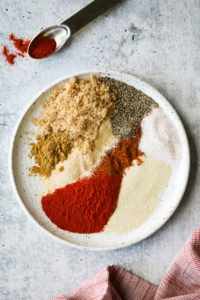
Time to make the pork rub
Combine all of the rub ingredients in a small bowl. Sprinkle the rub over the dry surface of the pork and use your hands to gently rub it into the meat.
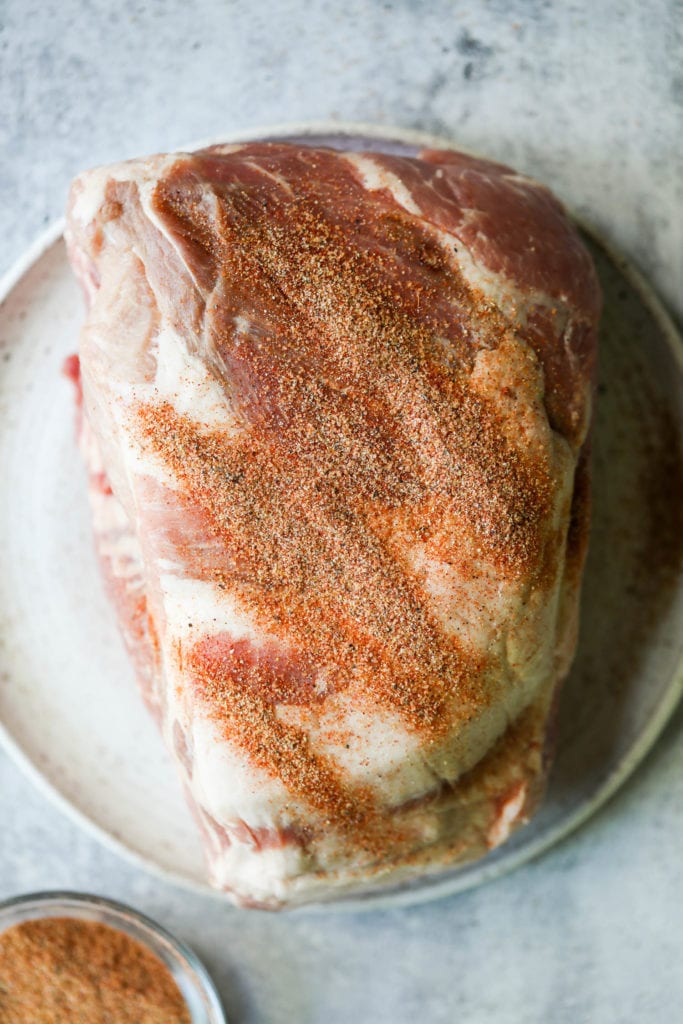
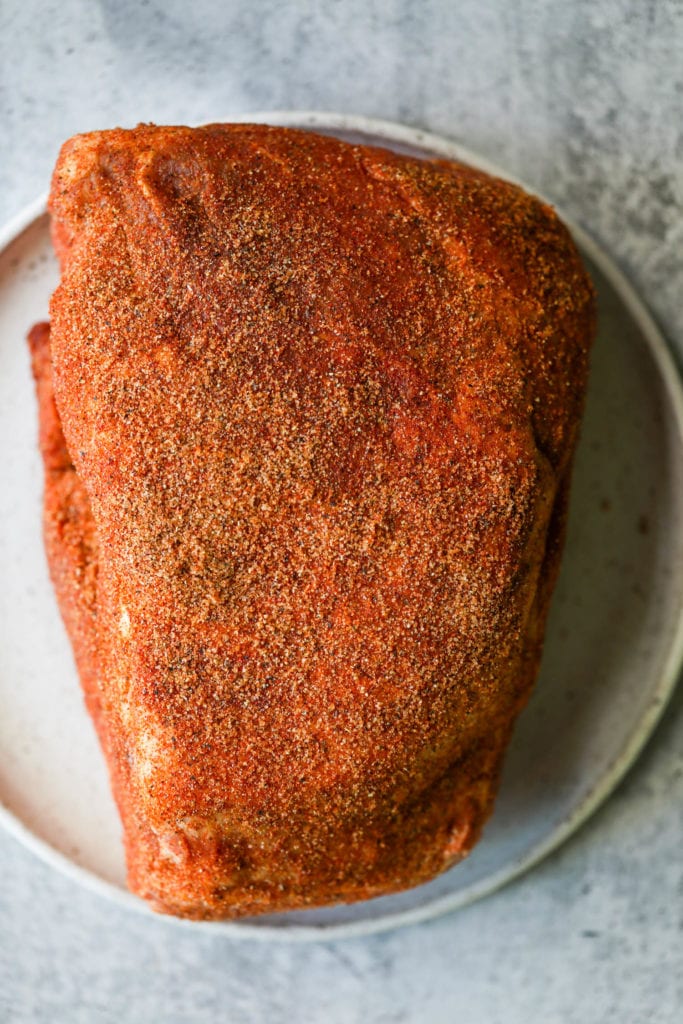
When the grill or smoker reaches 250℉, place the pork butt directly onto the grate with the fat cap facing up. Note: this is over indirect heat. You want the meat to slowly roast rather than cook directly over a flame.
Insert the temperature probe into the thickest part of the pork butt, being careful not to hit the bone. Close the lid. Then set the probe timer to alarm at 160℉. This should be somewhere in the ballpark of 2 ½ to 3 hours.
Now that the probe alarm is set, set a timer on your watch or phone for 1 hour then go inside and proceed to the next step.
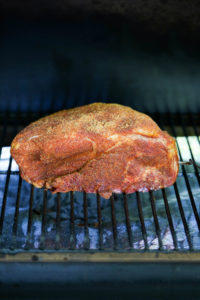
Get your sprayer ready
Grab that spray bottle and fill it with 2 cups of apple juice. You’ll use this liquid to spray the pork every hour until it reaches 160℉. To spray, just lift the lid and give the pork several spritzes, doing your best to spray the top and sides without burning yourself. Now reset your timer, close the lid, and continue cooking until it’s time to spray again or the probe alarm sounds.

When you see the temperature nearing 160℉, it’s time to set up for the next step. If you don’t have a Dutch oven or roasting pan that’s large enough for your pork butt to fit into, you can stack 4-5 large sheets of heavy-duty aluminum foil on top of one another (this is the brand we use because it’s thick, wide, and reliable).

Next, you’ll wrap the meat
Once the pork reaches 160℉, remove it from the grill or smoker either to the Dutch oven or roasting pan or to the foil (set on top of a baking sheet for support). If using foil, gather up the sides of the foil to create walls that will allow you to pour liquid into them. Pour the remaining apple juice from the sprayer into the pot or fortress of foil. Place the lid on the pot, cover the roasting pan with foil, or fold the foil sheets over the top of the butt and together to secure them tightly and prevent steam from escaping. Keep in mind that if you removed the temperature probe, you’ll need to reinsert it. So if you’re using foil, it’s best to wait until you’re back at the grill to seal the foil once the probe is back in.
This next part of the cooking process is where we bring in moist-heat cooking. This helps the proteins and collagen break down and relax, making that juicy, fall-apart tender Smoked Pork Butt.
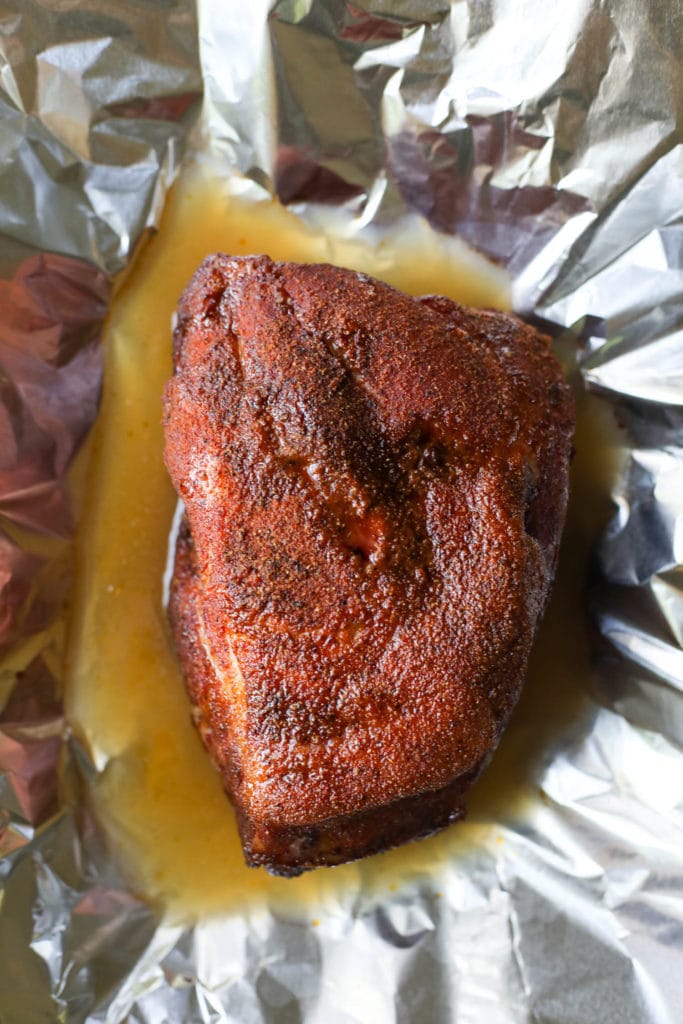
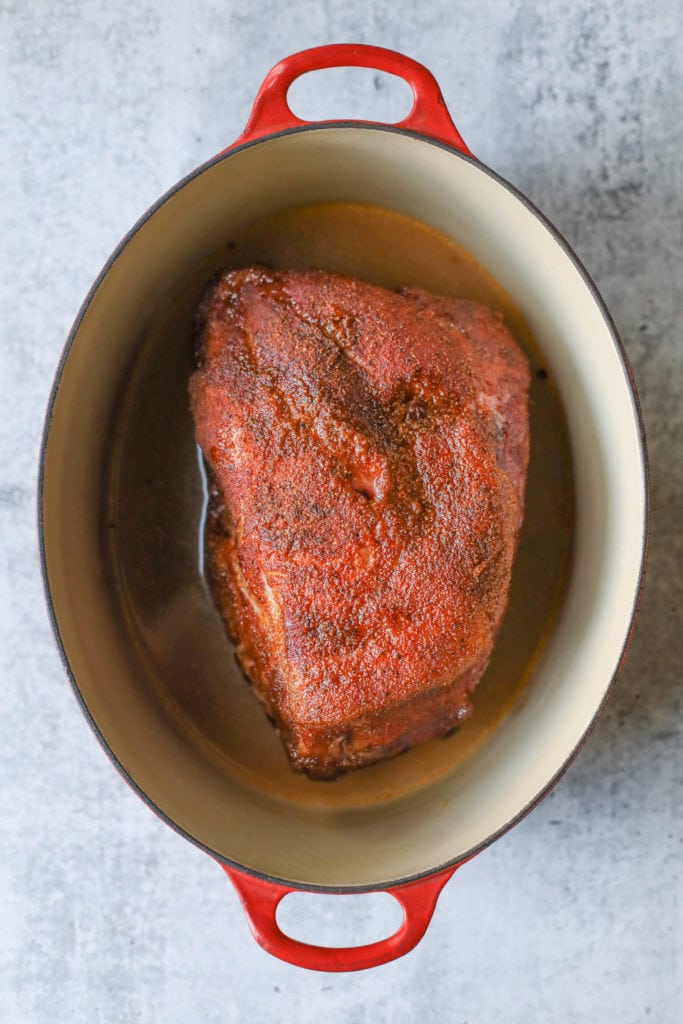
Let it smoke, let it smoke!
Return the pork to the grill or smoker (still over indirect heat and still at 250℉). Reinsert the probe into the thickest part of the meat, not touching the bone, if you haven’t already done so. Set the probe timer for 205℉ (actually, it’s 204℉ if you want to be exact but if you’re using a Traeger, the chances are good that your probe alarm can only be set in increments of 5℉). Don’t worry, that 1℉ won’t matter. The point is that you get it up over 200℉. Normally, you’d never take whole muscle cuts of pork like chops or tenderloin above 145℉ but smoked pork butt is special (in so many ways…just you wait and see!).
When the probe reaches 204-205℉ (about 3 hours) it’s time for the next step.
Don’t worry, aside from actually sitting down to a plate of perfectly smoked pork butt, this is the easiest step yet! Just remove the pot/pan/foil bundle from the grill and then allow it to rest at room temperature for 45 minutes. Now is a great time to put together your side dishes!!
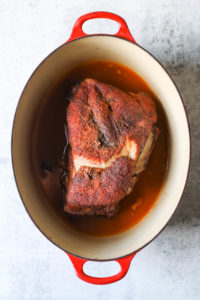
Time to rest and shred
After 45 minutes of rest, remove the pork to a large bowl, tray, or cutting board and allow it to rest another 10 minutes so that it’s easier to handle. Can’t wait? Grab a pair of CLEAN rubber dishwashing gloves and get started with the next step.
First, peel away and discard the fat cap. Then use your hands or 2 forks to shred the meat and remove the bone and any large pieces of fat or connective tissue. Sprinkle 2-3 tablespoons of apple cider vinegar over the meat and toss well to coat. Finally, taste and season with salt and pepper. Serve with the barbecue sauce of your choice, if desired.
Store any leftover smoked pork butt in an airtight container in the refrigerator for up to 4 days. Cooked pulled pork can be frozen for up to 2 months. To reheat, thaw overnight in the refrigerator and reheat in the microwave or in a covered skillet on the stovetop with a little water to keep the meat from drying out.
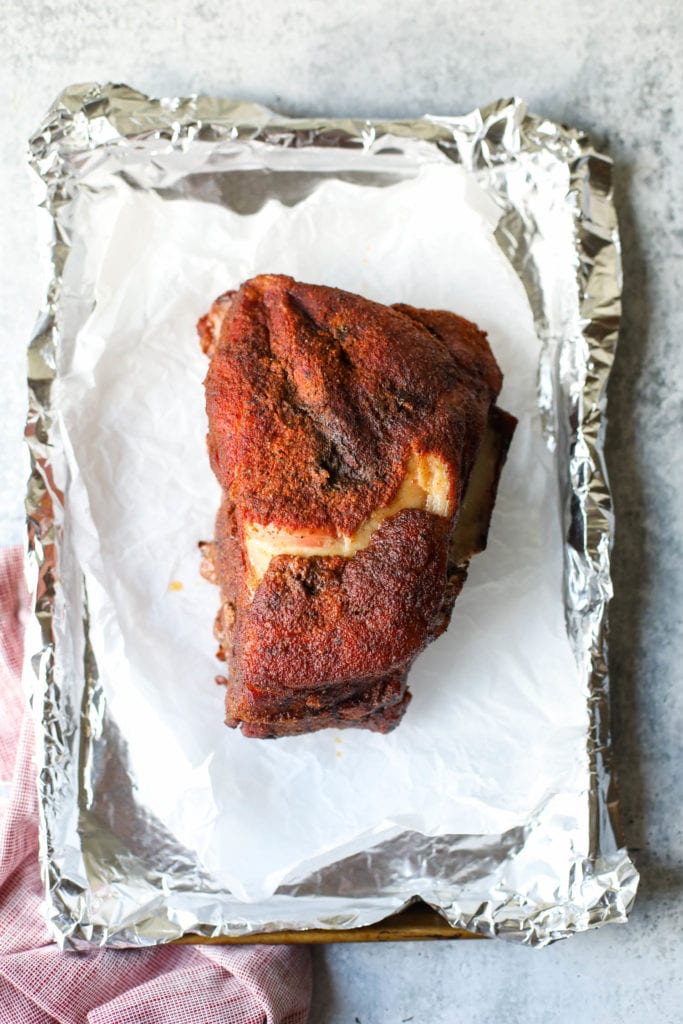
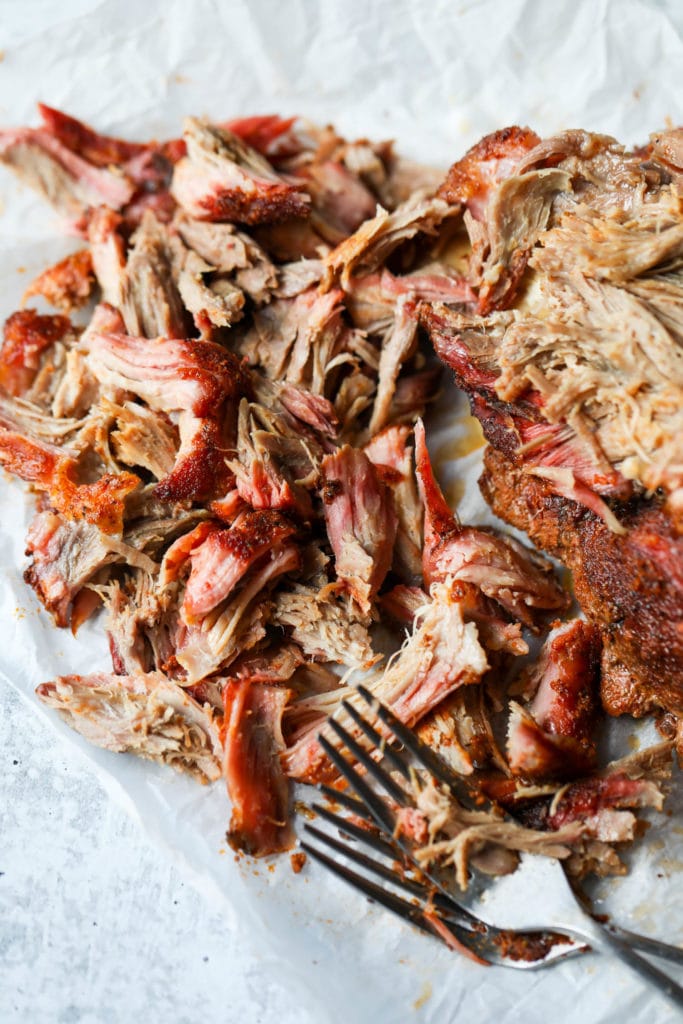
How much pulled pork does a pork butt make?
A 6 to 7-pound bone-in pork butt will provide 2 ¾ to 3 ¼ pounds of cooked, shredded pork once the bone and fat cap are removed. It’s safe to say that you will have enough to serve 10 to 12 hungry adults.
Other grilled pork recipes you might like:
- Grilled Pork Tenderloin with Avocado Green Sauce
- Grilled Pork Kebabs with Peanut Sauce
- Marinated Grilled Pork Chops
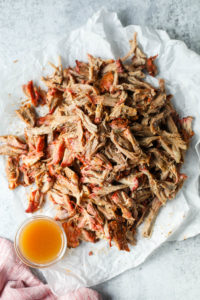
Hungry for More? Subscribe to get our newsletter delivered straight to your inbox! And be sure to stay in touch on Facebook, Twitter, Pinterest and Instagram for all of the latest updates.
Let’s Get Cookin’
Smoked Pork Butt
We make it easy to make the best Smoked Pork Butt at home with this simple, yet flavorful, recipe and tutorial.
- Author: Jessica Beacom
- Prep Time: 15 mins.
- Cook Time: 6 hours
- Total Time: 7 hours
- Yield: Serves 10–12 1x
- Cuisine: Gluten-Free, Whole30 option
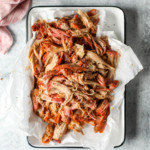
Ingredients
- 6 – 7 pound bone-in pork butt
- 2 teaspoons smoked paprika
- 2 teaspoons garlic powder
- 1 teaspoon onion powder
- 1 teaspoon chili powder
- ½ teaspoon ground cumin
- ⅛ teaspoon cayenne pepper (omit for less heat)
- 1 tablespoon brown sugar (light or dark), omit for Whole30-friendly
- Fine salt and ground black pepper
- 2 cups apple juice
- 3 tablespoons apple cider vinegar
Instructions
- If using a wood pellet grill or electric smoker, fill the hopper with your pellets of choice. We like hickory, pecan, apple, and cherry when making pork. If you’re using a gas grill, plan to soak your wood chips of choice overnight before draining them and adding them to a smoke box set at the back of the grill. Preheat the grill or smoker to 250℉.
- While the grill/smoker preheats, pat the pork butt dry with paper towels and set aside.
- To make the rub, in a small bowl, combine the paprika, garlic, and onion powders, chili powder, cumin, cayenne (if using), brown sugar, salt, and pepper. Sprinkle the rub over the dry surface of the pork and use your hands to gently rub it into the meat.
- Place the pork butt directly onto the grate of the preheated grill/smoker over indirect heat with the fat cap facing up. Insert the temperature probe into the thickest part of the pork butt, being careful not to hit the bone. Close the lid. Set the probe timer to alarm at 160℉ which should be somewhere in the ballpark of 2 ½ to 3 hours.
- Add 2 cups of apple juice to a clean spray bottle. Spray the pork butt with apple juice every hour (after the first hour) until the temperature of the pork reaches 160℉.
- Stack 4-5 large sheets of heavy-duty aluminum foil on top of one another on top of a baking sheet. Alternatively, you can use a large Dutch oven or roasting pan if you’re looking for a reusable option.
- Once the pork reaches 160℉, remove it from the grill/smoker either to the Dutch oven or roasting pan or to the foil (laid over a baking sheet for support). If using foil, gather up the sides of the foil to create walls that will allow you to pour liquid into them. Pour the remaining apple juice from the sprayer into the pot or fortress of foil. Place the lid on the pot, cover the roasting pan with foil, or fold the foil sheets over the top of the butt and together to secure them tightly and prevent steam from escaping. Keep in mind that if you removed the temperature probe, you’ll have to reinsert it. So if you’re using foil, it’s best to wait until you’re back at the grill to seal the foil once the probe is back in.
- Return the pork to the grill or smoker (still over indirect heat and still at 250℉). If yours is wrapped in foil, you can either leave it on the baking sheet. Reinsert the probe into the thickest part of the meat, not touching the bone, if you haven’t already done so. Set the probe timer for 205℉.
- When the probe reaches 205℉ (about 3-4 hours depending on the size of the butt) remove the pot/pan/foil bundle from the grill/smoker and allow it to rest at room temperature for 45 minutes.
- After 45 minutes of rest, remove the pork to a large bowl or a cutting board and allow it to rest another 10 minutes so that it’s easier to handle.
- Peel away the fat cap and discard. Use your hands or 2 forks to shred the meat and remove the bone and any large pieces of fat or connective tissue. Sprinkle 2-3 tablespoons apple cider vinegar over the meat and toss well to coat. Taste and season with salt and pepper. Serve with the barbecue sauce of your choice, if desired.
- Store any leftover smoked pork butt in an airtight container in the refrigerator for up to 4 days. May be frozen for up to 2 months. To reheat, thaw overnight in the refrigerator and reheat in the microwave or in a covered skillet on the stovetop with a little water to keep the meat from drying out
Nutrition
- Serving Size: 4 ounces cooked pork
- Calories: 276
- Sugar: 1 g
- Sodium: 90 mg
- Fat: 16 g
- Saturated Fat: 6 g
- Carbohydrates: 1 g
- Fiber: 0 g
- Protein: 30 g
- Cholesterol: 100 g
Pin it now & Make it later!
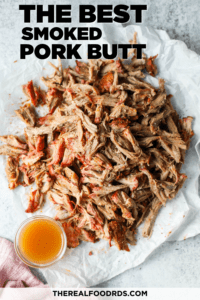
This post was made possible by our friends at the Minnesota Pork Board. Although we received compensation for this post, the opinions expressed here are – as always – 100% our own. Thank you for supporting the great companies we work with thereby allowing us to continue creating great recipes and content for you.
All photos and content are copyright protected. Please do not use our photos without prior written permission. If you wish to republish this recipe, please rewrite the recipe in your own unique words and link back to the source recipe here on The Real Food Dietitians. Thank you!
About Jessica Beacom
Jessica is a Registered Dietitian Nutritionist living in Boulder, CO with her husband and two daughters. She’s been described as a ‘real food evangelist’ and loves sharing her knowledge with others to help them break free of the diet mentality and find their own food freedom. In her spare time, she enjoys CrossFit, telemark skiing, mountain biking, and camping out under the stars.
